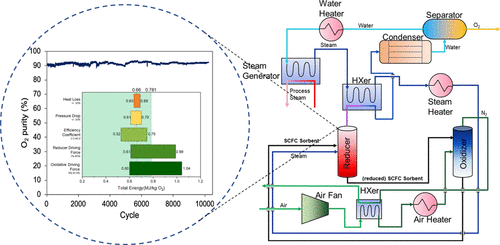当前位置:
X-MOL 学术
›
ACS Sustain. Chem. Eng.
›
论文详情
Our official English website, www.x-mol.net, welcomes your
feedback! (Note: you will need to create a separate account there.)
Chemical Looping Air Separation Using a Perovskite-Based Oxygen Sorbent: System Design and Process Analysis
ACS Sustainable Chemistry & Engineering ( IF 7.1 ) Pub Date : 2021-08-30 , DOI: 10.1021/acssuschemeng.1c03612 Emily Krzystowczyk 1 , Vasudev Haribal 1 , Jian Dou 1 , Fanxing Li 1
ACS Sustainable Chemistry & Engineering ( IF 7.1 ) Pub Date : 2021-08-30 , DOI: 10.1021/acssuschemeng.1c03612 Emily Krzystowczyk 1 , Vasudev Haribal 1 , Jian Dou 1 , Fanxing Li 1
Affiliation

|
Oxygen is a critical industrial gas whose global market is projected to reach $48 billion/year within this decade. However, oxygen production is highly energy-intensive because of the limited efficiency of the commercial cryogenic air separation technology. The present study systematically investigated a chemical looping air separation (CLAS) approach as an alternative to cryogenic distillation. In particular, a Sr0.8Ca0.2Fe0.4Co0.6O3−δ (SCFC) oxygen sorbent was used as the basis for both experimental and simulation studies. To demonstrate the sorbent robustness, experimental studies were carried out over 10,000 redox cycles in a bench-scale testbed. Excellent sorbent stability and >90% oxygen purity were achieved using steam as the purge gas. Oxygen purity can be further increased to >95% by optimizing the operating conditions and pressure swing absorption cycle structure. Based on the experimental results, a CLAS system design and a process model were established. The process model estimates a base case CLAS energy consumption of 0.66 MJ/kg O2. This represents a 15% decrease compared to cryogenic air separation (0.78 MJ/kg O2). It is noted that most of the thermal energy consumed by CLAS is at relatively low temperatures (∼120 °C). When accounting for the quality of this low-grade heat, an energy consumption as low as 0.40 MJ/kg O2 can be anticipated for a practical system. Sensitivity analysis was also performed on the various CLAS operational and design parameters such as reactor sizes, pressure drop, thermodynamic driving forces, oxygen uptake and release rates, heat loss, and the energy consumption for steam generation. It was determined that CLAS has excellent potential to be an efficient oxygen production technology. This study also highlights the importance of developing advanced sorbents with suitable redox thermodynamics and fast redox kinetics for improved efficiency and smaller reactor sizes.
中文翻译:

使用基于钙钛矿的氧气吸附剂的化学循环空气分离:系统设计和过程分析
氧气是一种关键的工业气体,其全球市场预计在这十年内每年将达到 480 亿美元。然而,由于商业低温空气分离技术的效率有限,制氧是高度能源密集型的。本研究系统地研究了化学循环空气分离 (CLAS) 方法作为低温蒸馏的替代方法。特别地,Sr 0.8 Ca 0.2 Fe 0.4 Co 0.6 O 3-δ(SCFC) 氧气吸附剂被用作实验和模拟研究的基础。为了证明吸附剂的稳健性,在实验室规模的试验台上进行了超过 10,000 次氧化还原循环的实验研究。使用蒸汽作为吹扫气体可实现出色的吸附剂稳定性和 >90% 的氧气纯度。通过优化操作条件和变压吸收循环结构,氧气纯度可以进一步提高到>95%。基于实验结果,建立了CLAS系统设计和过程模型。过程模型估计基本情况 CLAS 能耗为 0.66 MJ/kg O 2。与低温空气分离 (0.78 MJ/kg O 2)。值得注意的是,CLAS 消耗的大部分热能处于相对较低的温度(~120°C)。考虑到这种低品位热量的质量,可以预计实际系统的能耗低至 0.40 MJ/kg O 2。还对各种 CLAS 操作和设计参数进行了敏感性分析,例如反应器尺寸、压降、热力学驱动力、氧气吸收和释放速率、热损失和蒸汽产生的能量消耗。CLAS 具有成为高效氧气生产技术的巨大潜力。该研究还强调了开发具有合适氧化还原热力学和快速氧化还原动力学的高级吸附剂以提高效率和缩小反应器尺寸的重要性。
更新日期:2021-09-13
中文翻译:

使用基于钙钛矿的氧气吸附剂的化学循环空气分离:系统设计和过程分析
氧气是一种关键的工业气体,其全球市场预计在这十年内每年将达到 480 亿美元。然而,由于商业低温空气分离技术的效率有限,制氧是高度能源密集型的。本研究系统地研究了化学循环空气分离 (CLAS) 方法作为低温蒸馏的替代方法。特别地,Sr 0.8 Ca 0.2 Fe 0.4 Co 0.6 O 3-δ(SCFC) 氧气吸附剂被用作实验和模拟研究的基础。为了证明吸附剂的稳健性,在实验室规模的试验台上进行了超过 10,000 次氧化还原循环的实验研究。使用蒸汽作为吹扫气体可实现出色的吸附剂稳定性和 >90% 的氧气纯度。通过优化操作条件和变压吸收循环结构,氧气纯度可以进一步提高到>95%。基于实验结果,建立了CLAS系统设计和过程模型。过程模型估计基本情况 CLAS 能耗为 0.66 MJ/kg O 2。与低温空气分离 (0.78 MJ/kg O 2)。值得注意的是,CLAS 消耗的大部分热能处于相对较低的温度(~120°C)。考虑到这种低品位热量的质量,可以预计实际系统的能耗低至 0.40 MJ/kg O 2。还对各种 CLAS 操作和设计参数进行了敏感性分析,例如反应器尺寸、压降、热力学驱动力、氧气吸收和释放速率、热损失和蒸汽产生的能量消耗。CLAS 具有成为高效氧气生产技术的巨大潜力。该研究还强调了开发具有合适氧化还原热力学和快速氧化还原动力学的高级吸附剂以提高效率和缩小反应器尺寸的重要性。











































 京公网安备 11010802027423号
京公网安备 11010802027423号